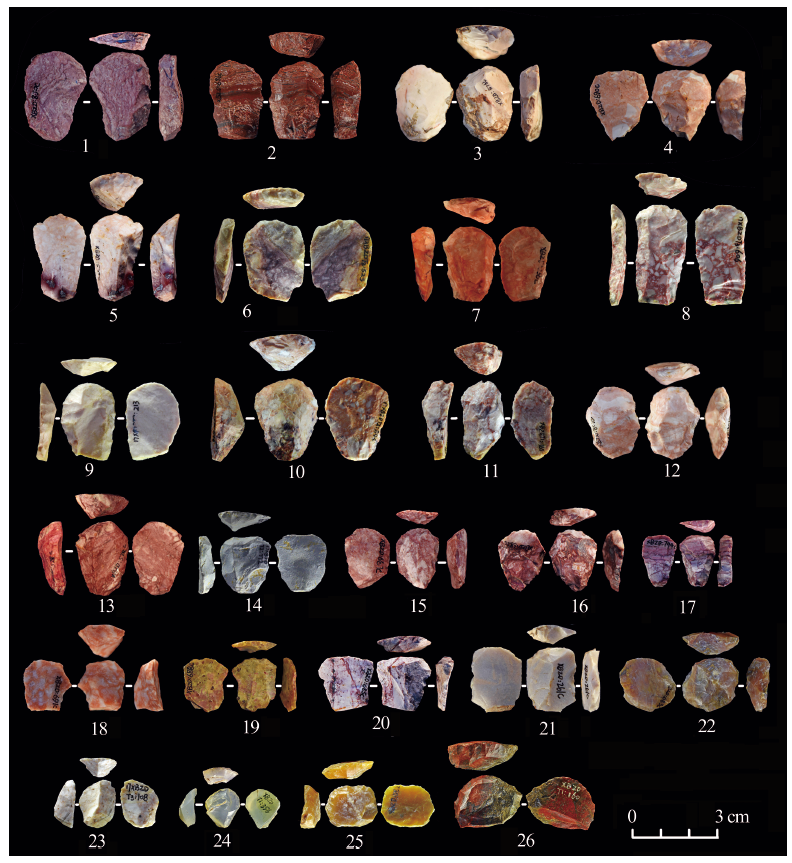

收稿日期: 2019-12-17
修回日期: 2020-08-27
网络出版日期: 2020-11-30
基金资助
中国科学院战略性先导科技专项B类(XDB26000000);国家社会科学基金项(17BGK030)
Experimental analysis of the endscrapers’ function from the Xiabozhuang site in Nihewan Basin of Hebei province
Received date: 2019-12-17
Revised date: 2020-08-27
Online published: 2020-11-30
端刮器常见于旧石器时代晚期的细石器工业中,形制比较固定,在探讨人类行为、生计以及环境适应等方面具有重要的研究价值。国外的研究涉及制作工艺、使用方式与功能等多个方面,而国内的研究多为类型学分析,对其功能的研究相对薄弱。河北泥河湾盆地下卜庄遗址出土了一定数量的端刮器遗存,本文通过模拟打制与使用实验,结合微痕分析方法,对它们的功能进行了探索,结果表明:1)下卜庄遗址的端刮器可能主要用来加工兽皮,且加工湿皮的现象较多;2)端刮器也可能直接被用来加工木材;3)部分端刮器微痕之间的关系表明,一些端刮器在使用过程中存在对刃缘的重新修理,当它们不再适合处理兽皮时会被用来加工木材,而后废弃。

赵海龙 , 仝广 , 闫晓蒙 , 杨淼燃 , 谭培阳 . 河北泥河湾盆地下卜庄遗址端刮器功能的实验分析[J]. 人类学学报, 2021 , 40(04) : 600 -610 . DOI: 10.16359/j.cnki.cn11-1963/q.2020.0076
Endscraper is a kind of typical stone tool. Although its retouching is quite simple, endscraper has great potential in studying human behavior, subsistence and adaptation to the environment. There are many researches on endscraper, including knapping technology, usage mode, functional analysis and so on. But in China, most of research is about typology and the functional research of endscraper is scarce. By combining the knapping and use of endscraper with the microwear analysis, we conduct a research about endscraper function. The result suggests that: 1) These endscrapers which are collected from the Xiabozhuang site, Nihewan Basin, North China, are mainly used to process hides, especially wed hides; 2) These stone tools are also used to process wood directly; 3)These tools were resharpened again when them became blunt, and after processing hides, some endscrapers were used to handle the wood until discarded.

Key words: Upper Paleolithic; Endscraper; Experiment; Microwear
| [1] | Goebel T, Powers R, Bigelow N. The Nenana complex of Alaska and Clovis origins[A]. In:Bonnichsen, Turnmire LK eds. Clovis: Origins and Adaptations[C]. Center for the Study of the First Americans, Oregon State University, Corvallis, 1991, 49-79 |
| [2] | Morrow JE. End scraper morphology and use-life: an approach for studying Paleoindian lithic technology and mobility[J]. Lithic Technology, 1997, 22(1):70-85 |
| [3] | Brooke SB. Aurignacian lithic economy and early modern human mobility: new perspectives from classic sites in the Vézère valley of France[J]. Journal of Human Evolution, 1999, 37(1):91-120 |
| [4] | Straus LG, Morales G. The Magdalenian settlement of the Cantabrian region (Northern Spain): The view from El Miron Cave[J]. Quaternary International, 2012, 272-273:111-124 |
| [5] | Shea J. Stone Tools in the Paleolithic and Neolithic Near East: A guide[M]. Cambridge: Cambridge University Press, 2013, 187 |
| [6] | Kozyrev A, Shchetnikov A, Klement’ev A, et al. The early Upper Palaeolithic of the Tunka rift valley, Lake Baikal region, Siberia[J]. Quaternary International, 2014, 348:4-13 |
| [7] | 杰列维扬科, 沃尔科夫, 李宪宗. 谢列姆贾旧石器时代晚期文化[M]. 译者:李有骞. 北京: 科学出版社, 2013 |
| [8] | 李昱龙. 阿尔泰地区旧石器中期向晚期过渡阶段的石器工业[J]. 西部考古, 2018(1):6-19 |
| [9] | Zwyns N, Gladyshev S, Gunchinsuren B, et al. The open-air site of Tolbor 16 (Northern Mongolia): Preliminary results and perspectives[J]. Quaternary International, 2014, 347:63-65 |
| [10] | Kimura B, Brandt AS, Hardy LB, et al. Analysis of DNA from Ethnoarchaeological Stone Scrapers[J]. Journal of Archaeological Science, 2001, 28:45-53 |
| [11] | Ray NC. Probable Uses of Flint End-Scrapers[J]. American Antiquity, 1937, 2(4):303-306 |
| [12] | Takase K. Use Angle and Motional Direction of End Scrapers: A Case Study of the Paleolithic in Hokkaido, Japan[J]. Asian Perspectives, 2010, 49(2):363-379 |
| [13] | Jensen JH. Functional Analysis of Prehistoric Flint Tools by High-Power Microscopy: A Review of West European Research[J]. Journal of World Prehistory, 1988, 2(1):53-88 |
| [14] | Siegel EP. Functional Variability Within an Assemblage of Endscrapers[J]. Lithic Technology, 1984, 13(2):35-51 |
| [15] | Gallagher PJ. Contemporary Stone Tools in Ethiopia: Implications for Archaeology[J]. Journal of Field Archaeology, 1977, 4(4):407-414 |
| [16] | 张晓凌. 丁村77:01地点和下川遗址细石器制品的类型初探[J]. 文物春秋, 2003(1):1-11 |
| [17] | 李占扬, 赵清坡, 鹿又喜隆. 河南灵井许昌人遗址细石器功能研究[J]. 第四纪研究, 2017, 37(4):789-796 |
| [18] | 王小庆. 陕西宜川龙王辿遗址第一地点出土石器的微痕观察[J]. 考古, 2017(11):100-111 |
| [19] | 张森水. 中国旧石器文化[M]. 天津: 天津科学技术出版社, 1987 |
| [20] | 武仙竹. 圆端刮器――中国一个古老的文化传统[J]. 四川文物, 2004(06):18-24 |
| [21] | 刘亚林. 端刮器及相关问题研究[D]. 长春:吉林大学文学院, 2016 |
| [22] | 谢飞, 成胜泉. 河北阳原油房细石器发掘报告[J]. 人类学学报, 1989(1): 59-68+104 |
| [23] | 盖培, 卫奇. 虎头梁旧石器时代晚期遗址的发现[J]. 古脊椎动物与古人类, 1977(4): 287-300+334-335 |
| [24] | 谢飞, 李珺. 籍箕滩旧石器时代晚期细石器遗址[J]. 文物春秋, 1993(2): 1-22+70 |
| [25] | 高星, 沈辰. 石器微痕分析的考古学实验研究[M]. 北京: 科学出版社, 2008 |
| [26] | 李罡, 任雪岩, 李珺. 泥河湾盆地二道梁旧石器时代晚期遗址发掘简报[J]. 人类学学报, 2016(4):509-521 |
| [27] | Zhang Y, Gao X, Pei SW, et al. The bone needles from Shuidonggou locality 12 and implications for human subsistence behaviors in North China[J]. Quaternary International, 2016, 400:149-157 |
| [28] | 宋艳花, 石金鸣. 山西吉县柿子滩遗址S29地点发掘简报[J]. 考古, 2017(2): 35-51+2 |
| [29] | 张晓凌, 高星, 沈辰, 等. 虎头梁遗址尖状器功能的微痕研究[J]. 人类学学报, 2010, 29(4):337-354 |
| [30] | 张晓凌, 沈辰, 高星, 等. 微痕分析确认万年前的复合工具与其功能[J]. 科学通报, 2010, 55(3):229-236 |
| [31] | 夏正楷, 陈福友, 陈戈, 等. 我国北方泥河湾盆地新–旧石器文化过渡的环境背景[J]. 中国科学(D辑):地球科学, 2001(5):393-400 |
| [32] | 阳原地方志编纂委员会. 阳原县志[M]. 石家庄: 河北人民出版社, 2011 |
| [33] | Albright SL. An Ethnoarchaeological Study of Tahltan Subsistence And Settlement Patterns[D]. Vancouver: the Department of Archaeology in the University of British Columbia, 1977 |
| [34] | 卡丽娜. 驯鹿鄂温克人文化研究[D]. 北京:中央民族大学, 2004 |
| [35] | 李晓曼. 鄂伦春、鄂温克、达斡尔族兽皮、兽骨装饰艺术研究[D]. 呼和浩特:内蒙古农业大学材料科学与艺术设计学院, 2013 |
/
| 〈 |
|
〉 |